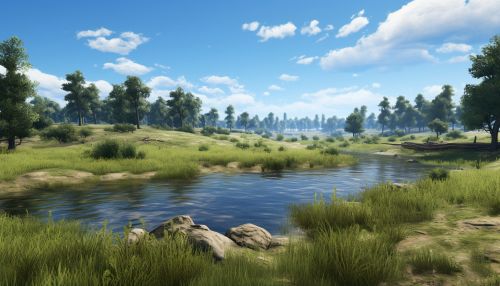Floodplain
Overview
A Floodplain is a flat or nearly flat land adjacent to a stream or river that experiences occasional or periodic flooding. It includes the floodway, which consists of the stream channel and adjacent areas, as well as the flood fringe, which is the area covered by floodwaters in severe events. Floodplains are natural features of the landscape, formed by the deposition of sediments over many years of flooding events.
Formation and Characteristics
Floodplains are formed through a process known as fluvial geomorphology. This involves the movement of sediments by rivers and streams, which are then deposited on the floodplain during flooding events. The size and shape of a floodplain are determined by the topography of the land, the size of the river, and the amount and type of sediment being transported.


Floodplains are characterized by their flat topography and fertile soils, making them ideal for agriculture. They are often used for farming, as the periodic flooding replenishes the soil with nutrients. However, this also makes them prone to flooding, which can cause damage to crops and infrastructure.
Ecological Importance
Floodplains play a crucial role in maintaining the health of an ecosystem. They provide habitat for a wide variety of species, including many types of birds, fish, and mammals. They also serve as natural flood control, absorbing and storing excess water during flooding events. This helps to reduce the impact of floods on human settlements and infrastructure.
Floodplains also play a vital role in nutrient cycling. The periodic flooding of these areas brings in nutrients from the river, which are then deposited in the soil. This makes floodplains some of the most productive ecosystems on the planet.
Human Interaction and Impact
Humans have been living and farming on floodplains for thousands of years. The fertile soils and flat topography make them ideal for agriculture. However, this has also led to a range of problems. The construction of levees and other flood control structures has altered the natural flow of rivers, leading to changes in floodplain ecosystems. This has resulted in a loss of habitat for many species, as well as changes in nutrient cycling.
In addition, human development on floodplains has increased the risk of flooding. As more land is developed, there is less natural area to absorb and store floodwaters. This can lead to more severe flooding events, causing damage to homes and infrastructure.
Management and Conservation
The management and conservation of floodplains is a complex issue. It involves balancing the needs of human communities with the need to protect and preserve these important ecosystems. This often involves the use of flood control structures, such as levees and dams, to protect human settlements. However, these structures can also have negative impacts on floodplain ecosystems.
One approach to floodplain management is the concept of 'room for the river'. This involves allowing the river to flood naturally, while moving human settlements out of the floodplain. This can help to preserve the natural function of the floodplain, while also reducing the risk of flood damage.
